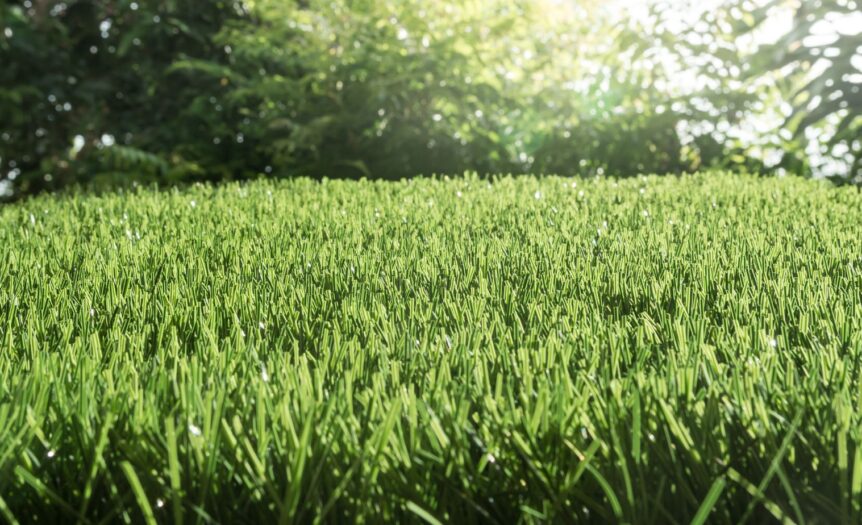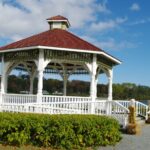When creating a lush, green lawn, turf material is crucial. Turf materials can vary widely in terms of composition, appearance, durability, and maintenance requirements. Understanding the different types of materials used for turf can help homeowners and landscapers make informed decisions that best suit their needs and environmental conditions.
Including landscape design elements alongside choosing the right turf materials can enhance the overall appeal and functionality of any outdoor space.
Let’s have a detailed look at the various materials commonly used for turf.
1. Natural Grass Turf
Natural grass turf, like Sir Grange Zoysia, is the traditional choice for many lawns and landscapes. It offers a genuine and aesthetically pleasing appearance. Several varieties are available, each suited to specific climates and uses.
- Warm-Season Grasses: These grasses thrive in hot, sunny climates and are more sustainable in the Australian climate. Common types include Bermuda grass, Zoysia grass, and St. Augustine grass. Bermuda grass is a good choice for high-traffic areas because of its resilience and resistance to drought. Zoysia grass offers a dense, carpet-like appearance and is relatively low-maintenance. St. Augustine grass is popular in coastal regions due to its salt tolerance and shade adaptability.
- Cool-Season Grasses: Ideal for cooler climates, these grasses remain green throughout the year in temperate regions. Types include Kentucky Bluegrass, Fine Fescue, and Perennial Ryegrass. Kentucky Bluegrass is prized for its lush, green colour and fine texture but requires regular maintenance. Fine Fescue is shade-tolerant and suitable for areas with less sunlight. Because of its rapid germination, perennial ryegrass is frequently used for overseeding.
Natural grass turf like Sir Grange Zoysia provides a soft, natural feel and has environmental benefits, such as air purification and temperature regulation. However, it requires regular maintenance, including mowing, watering, fertilising, and pest control.
2. Synthetic Turf
Synthetic grass, also referred to as synthetic turf, has grown in favour recently because of its longevity and low care requirements. It is made from synthetic fibres that mimic the appearance of natural grass and is commonly used in sports fields, playgrounds, and residential lawns.
- Polyethylene: This is the most common material used for synthetic turf. Polyethylene turf has a soft texture and a realistic appearance, making it suitable for residential lawns and recreational areas. It is UV-resistant, which helps prevent fading and degradation over time.
- Nylon: Nylon turf is the most durable and resilient synthetic grass. It is perfect for sports grounds and commercial uses since it can tolerate high foot traffic and harsh weather. However, nylon turf is more expensive and less realistic in appearance compared to polyethene.
- Polypropylene: This is the least expensive type of synthetic turf and the least durable. It is suitable for decorative purposes and areas with minimal foot traffic. Due to its lower resilience, it is not recommended for high-traffic areas.
Synthetic turf offers several advantages, including reduced water usage, minimal maintenance, and a year-round green appearance.
3. Hybrid Turf
Hybrid turf combines the best qualities of synthetic and natural grass. It blends artificial fibres into real grass to improve longevity and require less upkeep while preserving the natural feel and appearance.
Reinforced Natural Grass: In this approach, synthetic fibres are mixed with natural grass seeds and grown together. The synthetic fibres reinforce the natural grass, making it more durable and wear-resistant. This hybrid turf is commonly used in sports fields to withstand heavy use.
Stitched Hybrid Turf: This method involves stitching synthetic fibres into a natural grass surface. The synthetic fibres provide additional support to the natural grass, enhancing its durability and lifespan. Stitched hybrid turf is often used in stadiums and high-traffic areas.
Hybrid turf compromises the aesthetic and environmental benefits of natural grass while maintaining the durability and low maintenance of synthetic turf. Because it can tolerate high usage and needs less water and nutrients than natural grass, it is a popular option for public areas and sports facilities.
4. Turf Underlay Materials
In addition to the primary turf materials, the underlay or base materials play a critical role in the performance and longevity of the turf. Proper base preparation ensures good drainage, stability, and root growth for natural grass or secure anchoring for synthetic turf.
Sand: Sand is commonly used as a natural and synthetic turf base material. It provides good drainage, prevents waterlogging, and promotes healthy root growth in natural grass. For synthetic turf, a layer of sand helps anchor the turf and provides a firm, even surface.
Gravel: Gravel is often used with sand to create a stable and well-drained base. A layer of gravel beneath the sand helps improve drainage and prevent the base from shifting over time. This combination is vital for synthetic turf installations.
Geotextile Fabric: Geotextile fabric is used as a weed barrier and stabilising layer in turf installations. Placed between the soil and the base materials, it prevents weed growth and helps maintain the integrity of the base.
Geotextile fabric is instrumental in synthetic turf installations to prevent weeds from penetrating the turf surface.
Organic Matter: Adding organic matter to natural grass turf can strengthen its structure, increase the availability of nutrients, and encourage the formation of strong roots. Organic matter also helps retain moisture and supports beneficial microbial activity, contributing to a healthier lawn.
Understanding the different types of materials and their specific applications helps homeowners and landscapers make informed decisions that ensure long-term success and satisfaction with their lawns. By selecting the appropriate turf and underlay materials, one can achieve a lush, green landscape that meets one’s aesthetic and functional needs.










